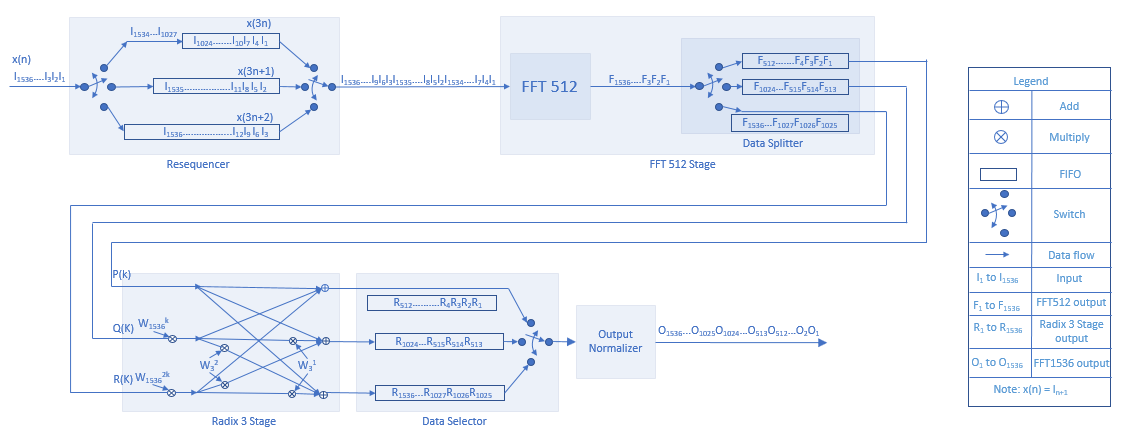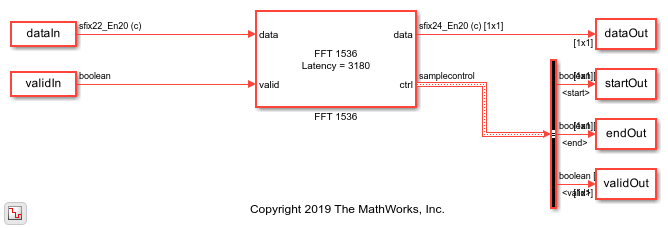FFT 1536
Computes fast-fourier-transform (FFT) for LTE standard transmission bandwidth of 15 MHz
Libraries:
Wireless HDL Toolbox /
Modulation
Description
The FFT 1536 block is designed to support LTE standard transmission
bandwidth of 15 MHz. This block is used in LTE OFDM Demodulator block
operation. The block accepts input data, along with a valid control signal and outputs
streaming data with a samplecontrol bus.
The block provides an architecture suitable for HDL code generation and hardware deployment.
Examples
Application of FFT 1536 block in LTE OFDM Demodulation
Use FFT 1536 block in LTE OFDM demodulation.
Ports
Input
Input data, specified as a scalar of real or complex values.
double and
single data types are supported for simulation, but not for HDL
code generation.
The more the fractional bits you provide in the input word length, the better the accuracy you receive in the output.
Data Types: double | single | int8 | int16 | int32 | fixed point
Complex Number Support: Yes
Indicates if the input data is valid. When the input valid is
1 (true), the block captures the value on the input
data port. When the input valid is
0 (false), the block ignores the input data
samples.
Data Types: Boolean
When this value is 1 (true), the block stops the current
calculation and clears all internal states.
Dependencies
To enable this port, select the Enable reset input port parameter.
Data Types: Boolean
Output
Frequency channel output data, returned as a scalar of real or complex values.
When the input is of fixed point data type, the output data
type is the same as the input data type. When the input is of integer type, the output
data type is of fixed point type.
Data Types: double | single | int8 | int16 | int32 | fixed point
Complex Number Support: Yes
Control signals accompanying the sample stream, returned as a samplecontrol
bus. The bus includes the start, end, and
valid control signals, which indicate the boundaries of the frame
and the validity of the samples.
start— Indicates the start of the output frameend— Indicates the end of the output framevalid— Indicates that the data on the output data port is valid
For more details, see Sample Control Bus.
Data Types: bus
Parameters
Main
Specifies the complex multiplier type for HDL implementation. Each multiplication
is implemented either with Use 3 multipliers and 5 adders
or with Use 4 multipliers and 2 adders. The implementation
speed depends on the synthesis tool and the target device that you use.
Specifies the type of rounding method for internal fixed-point calculations. For
more information about rounding methods, see Rounding Modes. When the input is any integer or fixed-point data type,
this block uses fixed-point arithmetic for internal calculations. This parameter does
not apply when the input data is single or
double.
When you select this parameter, the block divides the output by 1536. This option
is useful when you want the output of the block to stay in the same amplitude range as
its input. You require this option when the input is of fixed point
type.
When you select this parameter, the output word length increases by 2 bits and when you clear this parameter the output word length increases by 11 bits.
Control Ports
Select this parameter to enable the reset port.
Algorithms
To design an FFT 1536 block, radix-3 decimation-in-time (DIT) algorithm is implemented. The input sequence x(n) for all n = {0,1,2....1535} is divided into three DIT sequences, x(3n), x(3n+1), x(3n+2) for all n = {0,1,2....511}.
This equation defines FFT 1536 computation of a given sequence x(n).
The equation can be implemented by dividing it into three parts, where P(k), Q(k), R(k) are the N/3 (FFT 512) point FFT of x(3n), x(3n+1), and x(3n+2), respectively. Here, N = 1536, and k = 0,1,2,.....,511.
This diagram shows the internal architecture of the block and how the input sequence streams through the components of the block.

The input sequence x(n) is demultiplexed into three DIT sequences, x(3n), x(3n+1), x(3n+2), each of length 512. Three first-input first-output (FIFO) memories store these sequences. These DIT sequences are serialized and streamed through the FFT 512 block.
This image shows the output waveform of the block when operated with default
configuration parameters. The block provides output data after a latency of 3180 clock
cycles. The length of the output data between start
(Ctrl.(1)) and end (Ctrl.(2))
output control signals is 1536 clock cycles.

The performance of the synthesized HDL code varies with your target and synthesis
options. This table shows the resource and performance data synthesis results of the block
with default configuration parameters, along with normalization feature enabled, and with an
input data in fixdt(1,17,15) format. The generated HDL is targeted to
an AMD®
Zynq® XC7Z045-FFG900-2 FPGA board. The design achieves a clock frequency of 355
MHz.
| Resource | Number Used |
|---|---|
| LUTs | 7330 |
| Registers | 9325 |
| Block RAMs | 18 |
| DSPs | 36 |
Extended Capabilities
This block supports C/C++ code generation for Simulink® accelerator and rapid accelerator modes and for DPI component generation.
HDL Coder™ provides additional configuration options that affect HDL implementation and synthesized logic.
This block has one default HDL architecture.
| ConstrainedOutputPipeline | Number of registers to place at
the outputs by moving existing delays within your design. Distributed
pipelining does not redistribute these registers. The default is
|
| InputPipeline | Number of input pipeline stages
to insert in the generated code. Distributed pipelining and constrained
output pipelining can move these registers. The default is
|
| OutputPipeline | Number of output pipeline stages
to insert in the generated code. Distributed pipelining and constrained
output pipelining can move these registers. The default is
|
You cannot generate HDL for this block inside a Resettable Synchronous Subsystem (HDL Coder).
Version History
Introduced in R2019b
MATLAB Command
You clicked a link that corresponds to this MATLAB command:
Run the command by entering it in the MATLAB Command Window. Web browsers do not support MATLAB commands.
웹사이트 선택
번역된 콘텐츠를 보고 지역별 이벤트와 혜택을 살펴보려면 웹사이트를 선택하십시오. 현재 계신 지역에 따라 다음 웹사이트를 권장합니다:
또한 다음 목록에서 웹사이트를 선택하실 수도 있습니다.
사이트 성능 최적화 방법
최고의 사이트 성능을 위해 중국 사이트(중국어 또는 영어)를 선택하십시오. 현재 계신 지역에서는 다른 국가의 MathWorks 사이트 방문이 최적화되지 않았습니다.
미주
- América Latina (Español)
- Canada (English)
- United States (English)
유럽
- Belgium (English)
- Denmark (English)
- Deutschland (Deutsch)
- España (Español)
- Finland (English)
- France (Français)
- Ireland (English)
- Italia (Italiano)
- Luxembourg (English)
- Netherlands (English)
- Norway (English)
- Österreich (Deutsch)
- Portugal (English)
- Sweden (English)
- Switzerland
- United Kingdom (English)
